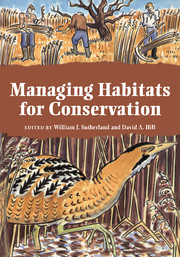Book contents
- Frontmatter
- Contents
- List of Contributors
- Acknowledgements
- 1 Introduction and principles of ecological management
- 2 Site management planning
- 3 Access
- 4 Coastal habitats
- 5 Rivers, canals and dykes
- 6 Waterbodies
- 7 Reedbeds, fens and acid bogs
- 8 Grasslands
- 9 Farmland
- 10 Lowland heathland
- 11 Upland moors and heaths
- 12 Woodland and scrub
- 13 Urban areas
- Some useful addresses
- Index of species by common names
- Subject index
13 - Urban areas
Published online by Cambridge University Press: 05 February 2015
- Frontmatter
- Contents
- List of Contributors
- Acknowledgements
- 1 Introduction and principles of ecological management
- 2 Site management planning
- 3 Access
- 4 Coastal habitats
- 5 Rivers, canals and dykes
- 6 Waterbodies
- 7 Reedbeds, fens and acid bogs
- 8 Grasslands
- 9 Farmland
- 10 Lowland heathland
- 11 Upland moors and heaths
- 12 Woodland and scrub
- 13 Urban areas
- Some useful addresses
- Index of species by common names
- Subject index
Summary
Introduction
The world is becoming increasingly urban. Already nine out of ten people in Britain live in towns. By the year 2020, it is expected that nine out of ten people in the rest of the world will do the same. The humdrum pressure of urban living makes human contact with the natural world more important than ever, so our towns and cities need to provide very easy access to relatively wild, green landscapes. For the old, and the very young in particular, wildlife on the doorstep is almost the only wildlife that counts. Ironically, almost all the commitments to habitat management, from central government funding and statutory protection, to practical action by enthusiasts on the ground, is directed towards remote rural landscapes, keeping rare species in protective custody, for the pleasure of the privileged few. If these exclusive habitats are to survive, then they need championing by the urban majority, who in turn must be inspired through familiarity with the wildlife they can see every day of the week.
The land resource
There is a myth that urban landscapes are concrete jungles, paved wall to wall with tarmac – a hostile environment where nature struggles to survive. In fact even the most densely built-up places have abundant open space, and in a typical western town or city, greenspace is in the majority. In Leicester, for example, 25% of the city's land area is occupied by private gardens, and the ‘official’ green open space of sports fields, public parks, school playing fields, hospital and college grounds, road verges and golf courses occupies almost as much again.
- Type
- Chapter
- Information
- Managing Habitats for Conservation , pp. 362 - 380Publisher: Cambridge University PressPrint publication year: 1995
- 3
- Cited by



